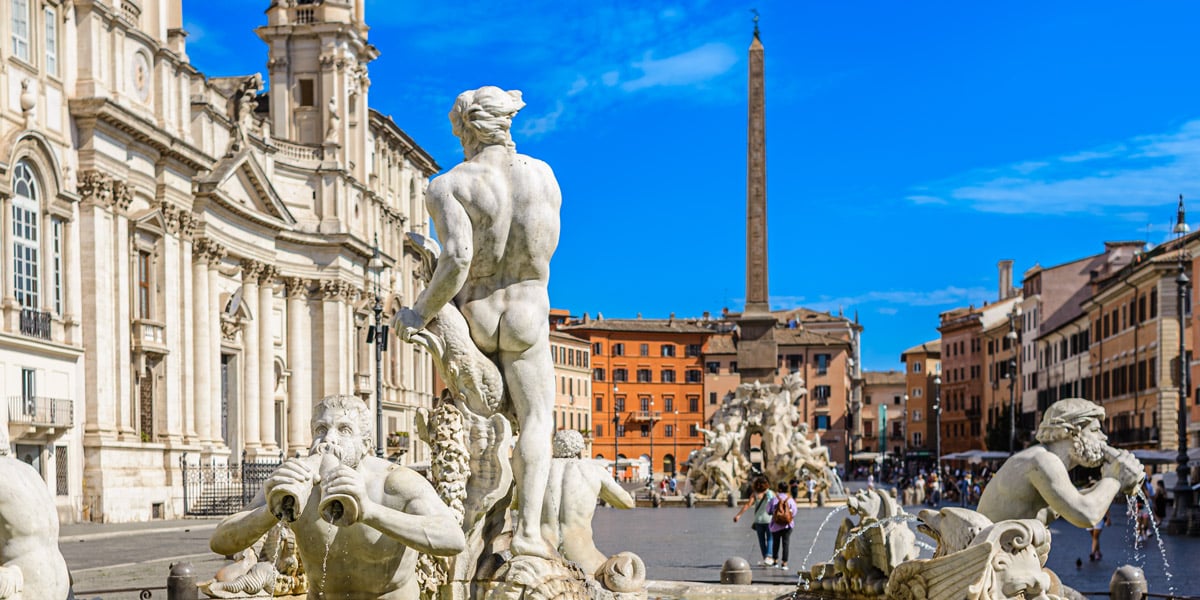

24837 views

| Tip | The third floor of the Museum of Rome (Braski Palace) offers a unique view of Navona Square. The museum is almost never crowded with tourists, and you can get there without booking tickets in advance. |
|---|---|
| Recommended tour | |
| Closest bus stops |
|
| Closest subway stations | |
| Address | Piazza Navona, Roma |
Piazza Navona is undoubtedly one of Rome’s most refined squares and bright corners. In ancient times, the athletic stadium was located on this spot of the urban land, and Romans watched the “agones” or the “games.”
Piazza Navona was previously known as “Circus Agonalis” or “competition arena.” Nowadays, all guests of the Italian capital can visit the majestic baroque fountains and medieval temples.
Contents
ToggleAs you wander through Rome’s historic heart, Piazza Navona awaits with its elegant Baroque artistry and deep roots in ancient history.
This iconic square, with its fountains, churches, and artistic masterpieces, hides intriguing tales that span centuries. Whether you’re an architecture enthusiast or a history buff, memorize a few facts about Piazza Navona and surprise your friends while walking around Rome. From the Stadium of Domitian’s footprint to the rivalry of legendary architects, Piazza Navona is a treasure trove of stories waiting to be explored.
Explore our editorial guide to places associated with Borromini masterpieces in Rome.
Originally known as the Stadium of Domitian (Stadio di Domiziano), Piazza Navona dates back to the 1st century AD.
Emperor Titus Flavius Domitianus commissioned this impressive stadium as a generous gift to the citizens of Rome. It was primarily intended for athletic contests and public events.
Initially called “Campus Agonis,” meaning “field of games,” the stadium’s name evolved over time, transforming into “n’agone” during the Middle Ages and ultimately being simplified into the modern “Navona.”
The ancient stadium measured approximately 275 meters by 106 meters and could accommodate up to 15,000 spectators. Surrounding arcades housed various merchants, entertainment venues, and social facilities. An intriguing historical anecdote: one of the nearby structures, once operating as a brothel, was eventually transformed into a church, highlighting Rome’s unique ability to reinvent itself over the centuries.
Built upon the ancient ruins of Domitian’s stadium in the 12th century, the Church of Santa Maria del Sacro Cuore played a significant role in Rome’s religious life. From the 13th to 17th centuries, it served as the national church for the Spanish community in Rome.
In the 19th century, under Pope Leo XIII, significant renovations were carried out, reorienting its main entrance directly onto Piazza Navona. Renowned Renaissance artist Francisco de Castello predominantly created the interior artwork and frescoes.
The Baroque period profoundly reshaped Piazza Navona, establishing it as one of Rome’s most striking public spaces.
At the end of the 15th century, prominent Roman families, notably the Pamphili, significantly influenced its cultural and architectural development.
In the 17th century, Cardinal Giovanni Battista Pamphili, who later became Pope Innocent X, commissioned the magnificent Palazzo Pamphili in the square’s southern area.
This palatial residence boasts 23 halls and an elegant gallery adorned by frescoes painted by Pietro da Cortona in 1651. Additionally, in 1672, the stunning Church of Sant’Agnese in Agone, Pope Innocent X’s final resting place, was incorporated into this complex.
Today, the historic Palazzo Pamphili houses the Brazilian Embassy.
Saint Agnes, or Santa Agnese, after whom the square’s famous Baroque church is named, was an influential early Christian martyr who lived between the late 3rd and early 4th centuries.
Renowned for her unwavering Christian faith, Agnes refused to sacrifice to the Roman goddess Minerva, which resulted in her being publicly humiliated and sentenced to a brothel.
Legend states that Agnes miraculously remained unharmed. When the magistrate’s son attempted to dishonor her, he was struck blind, only regaining sight after Agnes prayed for him. Despite these miracles, Agnes was executed around 305 AD. She was buried in the catacombs along Via Nomentana, where another notable basilica commemorating her was later constructed.
The Church of Sant’Agnese in Agone stands as both a place of worship and a Baroque masterpiece loaded with architectural drama.
The church was commissioned in the 1650s by Pope Innocent X and designed by the great architects Girolamo Rainaldi, Carlo Rainaldi, and later Francesco Borromini. It was built on the very site where, according to tradition, Saint Agnes suffered martyrdom.
Its construction was part of the Pamphilj family’s ambitious plan to dominate Piazza Navona with a palace and church complex. The dramatic Baroque façade, with its concave form and twin bell towers, directly faces Bernini’s Fountain of the Four Rivers. This led to a legendary (though likely apocryphal) tale: that the outstretched hand of the Rio de la Plata statue in the Fountain appears to “shield” itself from the church’s architecture—a witty nod to the fierce rivalry between Bernini and Borromini.
Inside, the church maintains a rich and solemn atmosphere, with a stunning dome fresco by Ciro Ferri, elegant marble, and the crypt that is said to mark the exact location of Saint Agnes’s martyrdom. The church is deeply tied to the narrative identity of the piazza, blending sacred history with theatrical Baroque flair.
You can read more about Sant Agnese in Agone.
Today, Piazza Navona continues as one of Rome’s most celebrated public squares, blending historical architecture with modern vibrancy.
It remains a center for cultural events, vibrant street life, artistic performances, and festive markets, connecting its rich past seamlessly to the present day.
Read also about the Top 25 Souvenirs to Bring Home from Rome.
Piazza Navona is renowned not only for its distinctive elongated shape—an echo of the ancient Stadium of Domitian—but also for its trio of exquisite Baroque fountains, each possessing its unique artistic significance and historical narrative.
Designed and enhanced by renowned architects and sculptors such as Gian Lorenzo Bernini, Francesco Borromini, and Giacomo della Porta, these fountains serve as iconic masterpieces that celebrate artistic ingenuity, engineering, and the symbolic power of water as an element of urban design in Rome.
Dominating the center of Piazza Navona stands the magnificent Fountain of the Four Rivers (Fontana dei Quattro Fiumi), masterfully crafted between 1648 and 1651 by the eminent Baroque sculptor and architect Gian Lorenzo Bernini.
This spectacular monument is fed by the waters of an ancient Roman aqueduct—the Acqua Vergine—a marvel in itself that underscores Rome’s enduring heritage of hydraulic engineering.
The Fountain celebrates the power and global reach of the Catholic Church under Pope Innocent X, symbolizing four major rivers from different continents known to Europeans at the time:
The dynamic energy of the statues, each river god carved from Travertine marble, vividly demonstrates Bernini’s remarkable ability to capture movement and emotional intensity within static stone forms. Additionally, the towering Egyptian obelisk crowning the Fountain further emphasizes Rome’s historical connection to antiquity, embodying both triumph and eternal endurance.
A notable historical narrative surrounds Bernini’s rivalry with his contemporary, Francesco Borromini. Borromini designed the adjacent church, Sant’Agnese in Agone, whose elegant Baroque façade directly faces Bernini’s monumental Fountain. Although Bernini and Borromini initially collaborated, their relationship evolved into fierce competition, frequently manifesting itself through artistic works commissioned by wealthy patrons.
It is a popular myth that Bernini deliberately sculpted the Rio de la Plata figure with an expression of horror and raised hand, ostensibly to mock Borromini’s façade—although historically, this is inaccurate, as Borromini’s church was completed after the Fountain’s unveiling.
For a deeper exploration, see a detailed guide to Borromini’s masterpieces in Rome.
The Obeliscus Pamphilius, initially commissioned by Emperor Domitian in the 1st century AD, now rises from the center of Bernini’s Fountain of the Four Rivers in Piazza Navona.
Carved in Egypt from red granite, the monument stands over 16.5 meters tall (30 meters with its base) and weighs more than 100 tons.
Rediscovered in ruins and relocated by Pope Innocent X in the 17th century, the obelisk became both an artistic and engineering centerpiece. Bernini’s design — considered risky at the time — was met with skepticism, prompting him to add symbolic sculpted ropes as a witty response to critics.
Its Latin inscription reframes this ancient pagan monument as a Christian triumph, aligning with the Pope’s political and spiritual vision.
Read more about the Obeliscus Pamphilius and its fascinating history.
Completing the trio at Piazza Navona’s southern end is the elegant Fountain of the Moor (Fontana del Moro), initially designed by Giacomo della Porta in 1575-1576.
The Fountain’s original form included dolphins and Tritons but lacked its central character until Bernini, nearly a century later (1653), enhanced it with the striking central sculpture known as “Il Moro.”
This central figure, sculpted by Bernini himself, dramatically portrays a muscular Moor wrestling with a dolphin set within an ornate shell-shaped basin. Around this dynamic scene are four Tritons spouting water, establishing a theatrical dialogue between architecture and nature. The strength and vitality depicted in Bernini’s Moor exemplify the Baroque fascination with emotional expression and dramatic narrative in sculpture.
In 1874, during an extensive restoration to preserve these historical sculptures, the original statues from the Fountain of the Moor were carefully transferred to the prestigious Galleria Borghese and replaced in Piazza Navona by precise replicas, safeguarding the delicate original artworks.
At the northern end of Piazza Navona stands Neptune’s Fountain (Fontana del Nettuno), initially designed by the acclaimed Renaissance architect Giacomo della Porta in 1574.
Initially, this Fountain was relatively simple and unadorned, lacking the ornate sculptures now associated with its final form.
Only during the extensive restoration works carried out in 1878 by sculptors Antonio della Bitta and Gregorio Zappalà did Neptune’s Fountain assume its current dramatic aesthetic. At the heart of the Fountain, Neptune—carved robustly in marble—wields his trident triumphantly, engaged in combat with an octopus, a metaphor for dominion over the seas. Surrounding the central figure are exuberant representations of sea creatures, nereids, and cupids. The Fountain’s energetic composition evokes the perpetual movement of water, effectively capturing the viewer’s eye and imagination, making it a cherished landmark for art connoisseurs and historians alike.
Braski Palace (Palazzo Braschi) was constructed in Rome in 1792.
Cosimo Morelli worked out the architectural design and became the supervisor of the construction activities. However, Napoleon’s invasion froze the decoration works until 1811. As a result, the Braski lost the right to obtain the palace, and the government couldn’t use such a luxurious and posh building.
Starting from 1949, Braski Palace was used as a shelter for 300 Italian families, and in 1952, it got the status of the Museum of Rome.
The museum is open from 9 am to 7 pm, and the price of the ticket is 9 euros.
Official website: www.museodiroma.it
Many luxury hotels are located near the Piazza Navona.
With the special filter, you can choose the best hotel for you.
Author: Artur Jakucewicz
This website uses cookies. For more info read the cookies policy
Rome.us © 2025. Created with love by Roman experts and guides.